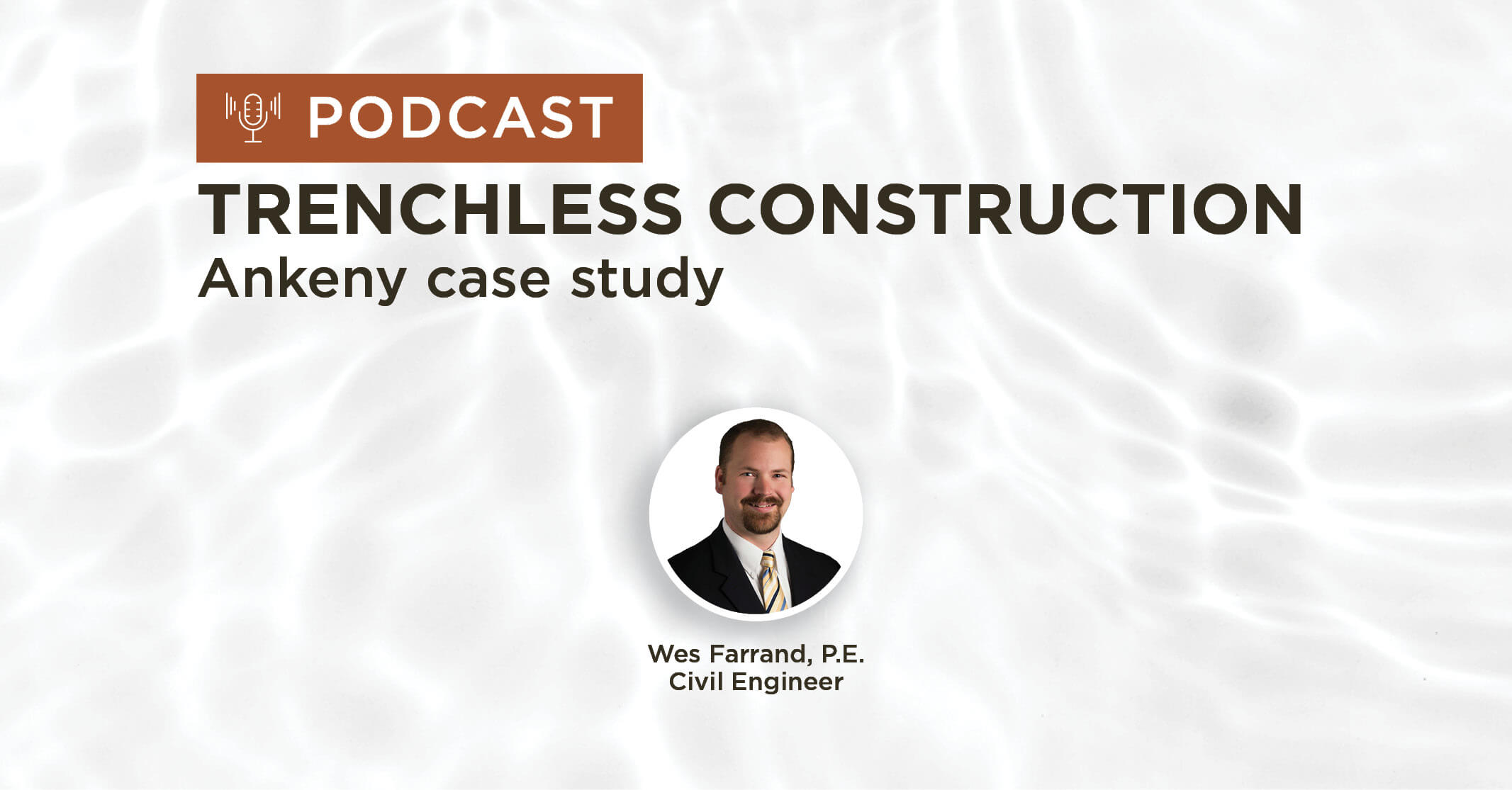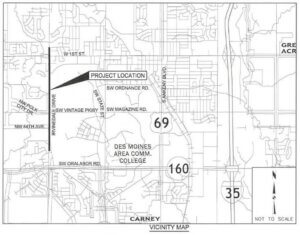Trenchless Construction Safely Installs Transmission Main with Minimal Disruption
As the City of Ankeny continues to expand, upgrading the city’s infrastructure is in a constant cycle to support the new housing and business construction — including the need for expanding water main transmission lines. This type of work is notorious for causing disruptions in neighborhoods and delays for motorists.
When confronted with a major water main transmission line project along Irvinedale Drive, our team offered a unique solution to keep public disruptions to a minimum. Listen in as Wes Farrand, P.E. explains how we used Horizontal Directional Drilling (HDD) on this project and greatly reduced the need for open-trench construction. This increasingly popular method required no street or trail closures, no utility disruptions, and limited harm to local landscaping.
Podcast Agenda
- Irvinedale Drive Project Background (0:17)
- Determining a Project Route to Limit Disruptions (1:49)
- Horizontal Directional Drilling (HDD) (3:38)
- Pipe Material Considerations & Selection (4:33)
- Construction of Irvinedale Transmission Main (5:29)

Wes Farrand, P.E.
Civil EngineerWes Farrand, P.E.
Civil EngineerCombined Sewer Planning & Design, Hydrologic & Hydraulic Analysis, Water Main design
Transmission Water Main Project Provides Reliable Water Service
(0:17)
The Irvinedale Drive is a transmission water main project that is part of the City of Ankeny’s overall Master Plan to provide reliable water service to the northwest area of the city. This area’s seen a lot of the city’s current growth in the past 15 years. They’ve grown from 27,000 to 60,000, and they’re planning for 130,000 residents, so the supply of water is a key part of making sure that all parts of the city can be served. The city’s current system gets its water sourced from Des Moines Water Works on the south side of the city, and the transmission and water mains through the city are limited in size.
So, the Master Plan the city completed in 2017 included several phases of transmission main to upsize the water system between the south source water and the northwest quadrant of the city. The Irvinedale project was a key phase in that it was the last link between the source water and the northwest booster station or the connection point that would provide the first large-diameter connection to that northwest quadrant.
There are additional phases that are still underway now that will provide redundancy and some looping, but this project is one that made that first connection and allowed the city to reduce their pressure zones from three down to two, and it allowed for a much more efficient and effective operation of the water system between their water towers and the booster pump station. It was important to the city to complete this on time and without incident or delay.
Determining a Project Route to Limit Disruptions
(1:49)
The route selected for the project followed the Irvinedale Drive. The challenge with that route is that Irvinedale Drive is a major arterial street. The city also has some corridor restrictions that were developed through public interaction. The residents relayed that they are very sensitive to disruption from construction. The Irvinedale Drive road had just seen a major reconstruction of that four-lane arterial just a few years prior, where traffic and pavement were disrupted for a significant amount of time. Some of the adjacent communities had also seen some relatively recent sanitary sewer construction projects. So, the feedback was that they really did not want to see any more disruptions, and the city felt that was a reasonable request.
One of the goals of the project was to avoid those disruptions. And so, the main roadway corridor of Irvinedale was determined to be off-limits, so to speak. The water main needed to be outside of that roadway, and we needed to avoid closures on Irvinedale Drive. Thankfully the corridor has a fairly wide right-of-way. There is a frontage road that travels along the west side of the roadway. The wide corridor and that frontage road provided a location for the water main to go without having to acquire easements.
However, the frontage road also posed another challenge in that a significant portion is restricted to only one access point. On that frontage road are several houses, as well as the business of the Ankeny Country Club. Shutting down the frontage road would cause additional disruption to traffic and very limited access, if any access, to those homes and that business.
The secondary goal of that was to avoid any significant closures of that frontage road as well. This led to the evaluation of trenchless construction to put in this water main, which would allow the construction work to proceed underneath the frontage road and across roadways to avoid the disruption or closures of roadways.
Horizontal Directional Drilling (HDD)
(3:38)
Just a few years earlier, the city had completed its first use of Horizontal Directional Drilling (HDD) for a major water main. They were pleased with the HDD method, and so they were open to using that again for this project in order to avoid the closures of the roadway and disruption to properties.
We identified key areas to use that HDD. Overall, it can be more expensive. However, when you factor in the restoration disruption right away for temporary construction, easements, pavement replacement, and then the intangible impacts of the roadway and public travel disruptions, those costs can start to balance out.
So, where open-cut was feasible, it was used, but then in areas where we needed to avoid the disruption, we used the HDD trenchless method to install the water main. This included along that frontage road that we needed to keep open. It also included a crossing of First Avenue, which is another east to west four-lane arterial road that had also relatively recently seen some reconstruction and some shutdowns so we avoided that.
Pipe Material Considerations & Selection
(4:33)
Additional to the hydraulic directional drilling, the city considered pipe materials and had never used fusible PVC on a project before, but there were some advantages, so we looked at that as an option, as well as normal restrain joint PVC and ductal iron in the areas that weren’t trenchless.
Ultimately, fusible PVC was used. The layout links and the layout areas for the project worked well with the fusible PVC. The city also appreciated the end product advantage of fusible PVC and that there are no joints when it is finally installed.
On previous projects, not in a trenchless application, but in an open cut application, they had contractors experience leaking joints, so the elimination of joints on this critical section of transmission main meant that there would be a less likelihood of having to do any kind of repairs that require excavation and potential disruption of the corridor that we were trying to avoid. Fusible also has a tighter radius of curvature so we were able to get around some of the utility conflicts and things in the field that made the construction quite successful.
Construction of Irvinedale Transmission Main
(5:29)
Construction was started in March 2020 and completed in November 2020. Over 4,200 feet of 24-inch PVC water main was installed by directional drilling on the project. The shortest boar was a 90-foot tunnel across Irvinedale to start it. The largest boar was over 700 feet and that required an intermediate fusion joint on the pipe in order to accommodate the shortened layout length for that area. But they were able to fuse that mid pull and were successful in getting that pulled in.
They had no drill fluid loss, no post-construction leak repairs, no street closures, no utilities were disrupted, and no other issues were on the project. It was very successful overall. The success of the project has given the city much greater confidence in the HDD method of installing a trenchless water main.
In a community that values a lot of its vegetation, its trails, and its roadways, that’s a very positive option the city can use to help avoid those impacts. In fact, the city is looking to undergo the next phase of the project here in less than a year that will tunnel about 5,000 feet of a 10,000 feet project in order to avoid impacts to a popular recreation trail, vegetation, and streets there as well.
The Irvinedale transmission main is one of several transmission main projects we’ve done with the City of Ankeny. For the first project that they used the HDD on, Snyder & Associates was a part of that project. This project was the first project where they used fusible PVC with HDD, we were part of that project, and we were looking forward to being involved with the city on multiple future transmission main projects where we’ll likely use trenchless construction for all of its advantages and benefits on those as well. We’re looking forward to that.

